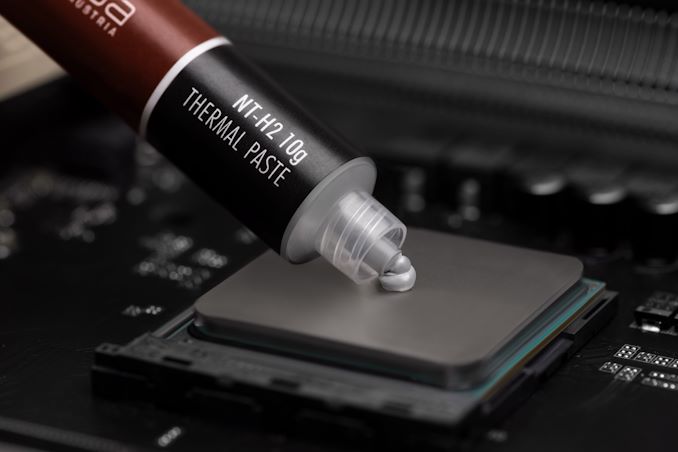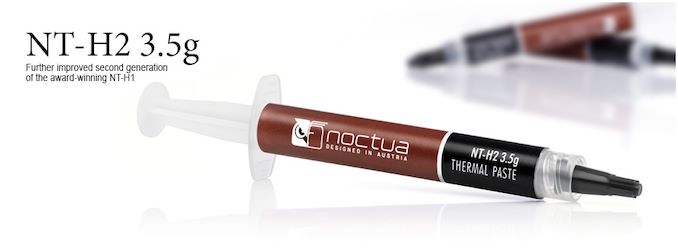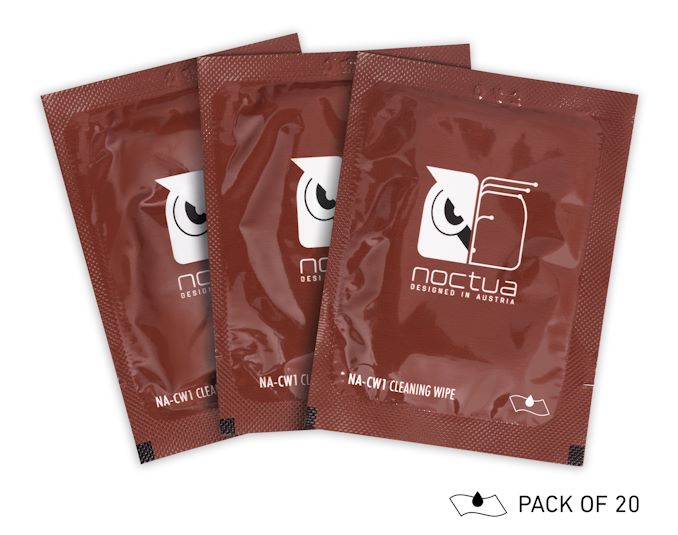Noctua's New NT-H2 Thermal Compound
by Gavin Bonshor on January 29, 2019 1:00 PM EST
Noctua has today unveiled its new NT-H2 thermal compound as well a new cleaning solution with the NA-SCW1 cleaning wipes. The NT-H2 looks to improve upon the already existing NT-H1 thermal paste with a new chemical structure and zerocuring time.
The new Noctua NT-H2 thermal compound builds upon the previous success of the NT-H1 material with a new blend of metal oxide microparticles for an improved and lower thermal resistance. The lower bond-line thickness with conventional mounting pressures allows for less air cavity concentration which should provide better thermal conductivity between the heatsink plate and the heat spreader. As with the Noctua NT-H1 compound, the new NT-H2 doesn't require a curing period and Noctua state that an application of NT-H2 can be used effectively for up to 5 years on a CPU.
The Noctua NT-H1 thermal paste was tested in a 50-paste round-up I did back in 2017
Noctua, as per their own in-house testing, determined that the NT-H2 operates up to 2°c lower than NT-H1. The NT-H2 is also non-corroding and non-conductive so there's no risk of short-circuiting components and is suitable to use with all types of heatsinks including copper, aluminium and nickel plated.
Noctua has released the NT-H2 thermal paste in two different packages; a standard 3.5 g and larger 10 g tube. Packaged with the smaller NT-H2 3.5 g paste is three new NA-CW1 cleaning wipes while the larger NT-H2 10 g will come with ten. The new Noctua NA-SCW1 cleaning wipes are designed to clean CPUs, GPUs and the contact surfaces of heatsinks. Each individual wipe is moistened with a custom detergent mixture for enhanced cleaning capability, but Noctua hasn't highlighted which materials have been used. Noctua's NA-CW cleaning wipes are available seperately in packs of 20.
On the back of the NT-H2 announcement, Noctua has revealed that it will be launching its NT-H1 thermal compound in a new 10 g package which is set to retail for 14.90 USD/EUR; the existing NT-H1 3.5 g costs 7.90 USD/EUR. There is currently no indication whether or not the new NT-H1 10 g package will include the cleaning wipes.
The new NT-H2 3.5 g will cost 12.90 USD/EUR with the 10 g package will cost 24.90 USD/EUR, while the NA-SCW1 20 pack of cleaning wipes will retail for 7.90 USD/EUR. All of these are set to hit Amazon channels within the next few days, while the stock is set to filter through to partners and retailers shortly.
Source: Noctua












34 Comments
View All Comments
Marlin1975 - Tuesday, January 29, 2019 - link
How much does thermal paste play into temps today? I do not see them talked about as much versus much older chips/designs.philehidiot - Tuesday, January 29, 2019 - link
I suppose that it depends on your application. If you're running games then these days the CPU really isn't stretching itself and on top of that the TDPs for such CPUs just aren't in the realm they used to be. That being said, there are some use cases that do really tax a CPU and throw off some heat and you can well imagine that if your mobo Tau settings are appropriate for sustained boost that your peak sustained performance could hinge on a couple of degrees. This being said, it's gamers that tend to be targetted by the brands and the subject of "gotta have the best" advertising. They're probably more impulse buy prone and science blinded (as well as RGB shiny shiny bling bling blinded - I mean, GOLD LIGHT UP RAM?!) than your real high end workstation / server user who buys with their head. I'd be interested to hear from such people as to whether they use high quality paste or just use the basic stuff and apply it right...Questor - Wednesday, January 30, 2019 - link
I hate RGB, but I do water cool and overclock. I do use high end pastes and TIMs, with the exception of liquid metal. I used to use it, but no longer. That's another story.I don't do extreme OCing as in liquid nitrogen. I do enjoy dialing in the clock speeds to see how far I can go. Better pastes are worth it to me. They do generally make a few degrees difference.
It's much like motor oil. There are basic brands that are fine and will protect your engine. They will also be good enough to keep your warranty in effect. However, there are other oils that do a better job lubricating, keeping the engine clean and prolonging the life of seals. It's the same with better TIM pastes and greases.
dromoxen - Thursday, January 31, 2019 - link
and the Penguins , toopiroroadkill - Wednesday, January 30, 2019 - link
Yeah, it's still as important as it once was, why wouldn't it be?zodiacfml - Wednesday, January 30, 2019 - link
Certainly not worth the money. Lower TDPs also lowers the potential of more expensive cooling products. If you are an enthusiast for higher numbers then go for it.BurntMyBacon - Friday, February 1, 2019 - link
This depends as well. With lower TDPs, we also have a plethora of smaller form factors and with that often comes smaller and less performant cooling solutions. Higher quality TIM may still be important in this case. There is also the philosophy that even with a monstrous cooler you don't want your cooler held back by using a peanut butter class TIM.I personally see a point at which the increase in cost of the TIM doesn't match the performance difference and recommend that my clients stick with a good quality TIM (not particularly hard to find) at a more reasonable price (this is lower than many think). That said, overall cost of the cooling solution plays a role here. As an extreme case, if you are going to spend $500 or more into a liquid cooling system, why would you risk using a lesser quality TIM to save a few dollars.
kadajawi - Friday, August 30, 2019 - link
Mh. Not so sure about that. The Ryzen 5 3600 produces quite a bit of heat which is rather difficult to remove from there. Seems like the shape of the heatspreader doesn't help, which means you need a good paste to make contact. And my Noctua D15 is running COLD. Like, room temperature, while the CPU underneath is at 90°C. Because it will just keep the warmth to itself. We are talking about a CPU pushing at most about 100 W TDP into a cooler capable of much more, and yet it gets too hot.Given how sensitive the Ryzen 3000 series is to warmth... as in they need to be cold in order to be fast... yeah, that is an issue. Anything that will help me transfer the heat to the cooler is very much appreciated.
FastCarsLike - Sunday, April 26, 2020 - link
Well.. considering I've been using Kryonaught for years, the benchmark they used says this new formulation is 1C cooler. To me, that's not worth the effort of switching thermal pastes. Maybe for the next guy?jameserlay - Tuesday, January 29, 2019 - link
"The new Noctua NT-H1 thermal compound builds upon the previous success of the NT-H1 material..."What?